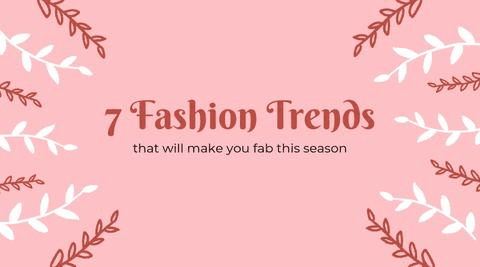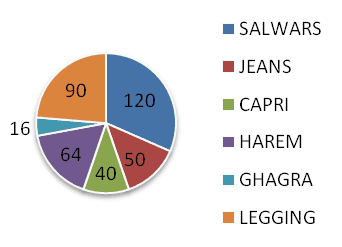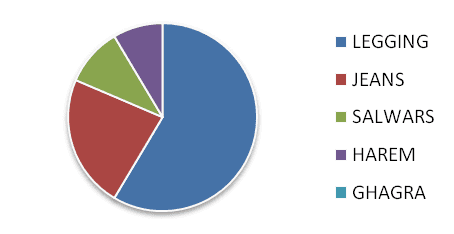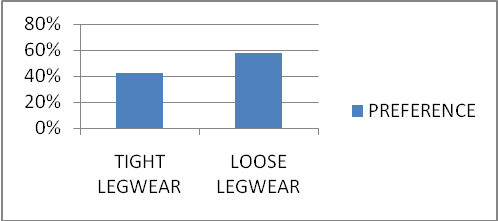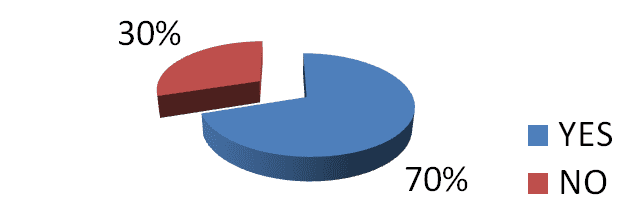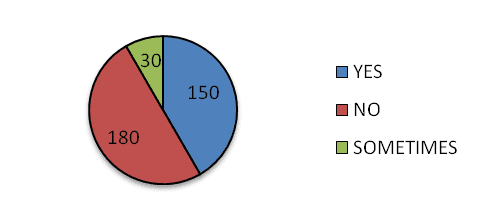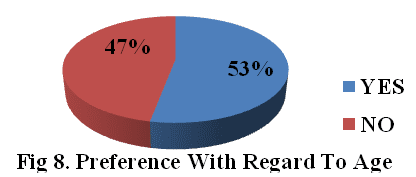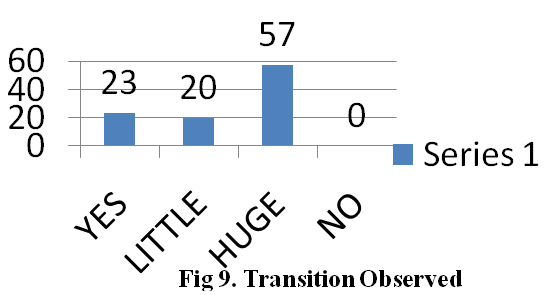Padia D. and Dedhia E.
Nirmala Niketan College of Home Science
49 New Marine Lines, Mumbai 400020
Abstract:
Changing trends of legwear were studied through observation and questionnaire method. It was observed that the most preferred legwear was changing according to changing trends. Women working outside their home preferred loose legwear while housewife’s preferred their traditional wear according to their culture
Introduction:
One of the basic human want is clothing and change. Clothing plays its vital role in every aspects of our life. There is a great transition in the concept of clothing from centuries ago till now. And there is also need to change they clothing concept as change is he only concept which is constant. There is a change in clothing and fashion trends, and almost every six months. This has an important role in the fashion industry in India has increased dramatically. The present increase in economic growth in India was an important influence on changes in fashion. Consciousness and the average purchasing power have caused a sudden explosion. The input of the computer industry is rapidly changing labour market and culture. Notable is the need to wear comfortable clothes during the long hours led to a change in overall demand for office wear. Styles of India fashion wearing saris and salwar-kameez have changed. The look has become more of metro. So in this sense believe our clothing and style changes as we change, as technology becomes more advanced, and as our attitudes change as a society. The way fashion changes can show how a society or culture changes and evolves. There is a significant change in women wardrobe specifically in the legwears as there has been lot of varieties which have come and gone from the market, being fad or classic.
- The oldest leg wear used by the Indian women is Ghagra choli which was observed around 1872 gaining popularity. Ghagra choli, which is also known as Lehenga choli, is the traditional clothing of women in Rajasthan, Gujarat, Madhya Pradesh, Uttar Pradesh, Haryana, Himachal Pradesh and Uttarakhand. Chaniya choli is another term commonly used to refer it. It is a combination outfit of a Lehenga, tight Choli and a Dupatta.Lehenga or Ghagra is a form of skirt which is long, embroidered and pleated. It is worn as the bottom portion of a Ghagra choli. The ancient version of skirt or Ghagra evolved from Bhairnivasani, which in turn evolved from the Antariya when stitched on one side became tabular and was worn gathered together at the waist, and held by a girdle. This was one of the earliest forms of a clumsily stitched skirt. It was worn using drawstring or nada. The ghagra was a narrow skirt six feet long the same length as original antariya. This style can still be seen worn by Jain nuns in South Asia and during festive and auspicious and sacred occasions in Rajasthan, Gujarat, Madhya Pradesh, Uttar Pradesh, Haryana, Himachal Pradesh and Uttarakhand.
(Http://www.Lifescript.Com/life/style/your-look/the_brief_history_of_fashion_trends.Aspx)
- A Patiala salwar which was accepted by Indian women during 1980 is a type of female trousers which has its roots in Patiala City in the Northern region of Punjab state in India. The King of Patiala in earlier times had its Royal dress as Patiala Salwar. The Patiala Salwar has a close resemblance to the pathani Suit which has similar loose lowers as salwars (Salwar are gathered at the waist and held up by a drawstring or an elastic band) and long knee length top known as Kameez. Over the decade the dress now is not worn by men but has classically transformed itself with new cuts and styling into women’s Patiala Salwar. The reason why the Patiala dress is preferred by most of the women of Punjab and other regions of Northern India is its comfort ability and durability in summers. Since the Patiala salwar is very loose and stitched with pleats it’s a very comfortable outfit to wear. Its distinguishing characteristic is folds of cloth stitched together that meet at the bottom. Patiala salwars require double the length of material to get stitched. The fall of the pleats of the Patiala Salwar is such that it gives a beautiful draping effect. (Http://www.Lifescript.Com/life/style/your-look/the_brief_history_of_fashion_trends.Aspx)
- Harem pants or harem trousers, also known as parachute pants were observed gaining popularity among Indian women after ghagra around 1988-1989. Harem pants are women’s baggy long pants tapered at the ankle, with side flaps on the hip that button at the waist Harem pants, which originated in India, are like a cross between a skirt and a pair of skinny jeans. The legs, from the knees down, are fitted. The crotch area is loose and baggy as if it were cut to be a skirt. Traditional harem pants can be extremely large and baggy, with a very wide and full fit, very roomy, loose fitting, oversized, puffy, spacious, with elastic in waist and at ankles, and with the crotch below the knee almost to the ground. Harem pants are commonly worn with a pleated skirt— a short skirt that covers the top portion of the harem pants. They’ve also emerged as a “modern” version of harem pants made popular in the late 1980s by MC Hammer and thus known as hammer pants. They are intended to be made more fashionable. Similar pants are also known as dimije, tshalvar, schalwar, salwar kameez, kaccha, Patiala salwar, shintijan, sirwal, sharovary, Turkish trousers, aladdin pants, balloon pants, drop crotch pants, pantaloons, zouave, pluderhose and pumphose.
- Women wearing pants (trousers) were thought by some to be historically almost non-existent, apart from Amazonian women, but have become more commonplace since the advent of feminism in the middle to late 20th century. Amazon wearing trousers and carrying a shield with an attached patterned cloth and a quiver. In the 1970s, trousers became especially fashionable for women today; trousers are worn by many women while skirts and dresses remain common as well. Women began wearing trousers in the later 20th century by Indian women. (Http://www.Lifescript.Com/life/style/your-look/the_brief_history_of_fashion_trends.Aspx)
- Jeans are trousers made from denim or dungaree Often the term “jeans” refers to a particular style of pants called “blue jeans” and invented by Jacob Davis and Levi Strauss in 1873. Starting in the 1950s, jeans, originally designed for cowboys, became popular among teenagers, especially members of the greaser subculture. Historic brands include Levi’s, Lee, and Wrangler. Jeans come in various fits, including skinny, tapered, straight, boot cut and flare. Jeans are now a very popular article of casual dress around the world. They come in many styles and colours; however, “blue jeans” are particularly identified with American culture, especially the American Old West. (Http://www.Lifescript.Com/life/style/your-look/the_brief_history_of_fashion_trends.Aspx)
- Capri pants (also known as Capri’s, Crop pants, long or three-quarter shorts, and clam diggers) are mid-calf pants worn in warm weather. Variants end below the knee and calf. Though widely popular with women they are also worn by men in many countries, especially in Europe, Latin America and Asia Capri pants were introduced by European fashion designer Sonja de Lennart in 1948. The pants’ name derives from the Italian isle of Capri, where they rose to popularity in the late 1950s and early 1960s. Capri’s’ acceptance in the United States was influenced by the 1960s television series. After a drop in popularity during the 1970s through the 1990s Capri’s returned to favour during the 2000s.
- Leggings are a type of skin-tight clothing covering the legs, which can be worn by both men and women. Originally leggings were two separate garments, one for each leg.Modern leggings are typically made from a blend of lycra, spandex, nylon, cotton, or polyester blend, but they can also be made from wool, silk and other materials. Leggings are available in a multitude of colours and decorative designs. Leggings in the form of skin-tight trousers, a tighter version of the Capri’s ending at mid-calf or near ankle length, made its way into fashion in the 1960s. It was very common to see leggings worn with long oversized t-shirts, oversized sweatshirts or oversized sweaters, slouch socks and Ked. Fashion turned against leggings in the late 1990s.In 2005, leggings made a “comeback” into high fashion, particularly in indie culture, with Capri-length leggings being worn with mini skirts and dresses. Consequently, leggings are also now popular to wear with oversized, long sweaters, denim mini skirt, plaid skirts, and short dresses. Shiny leggings, sometimes called leather-look leggings have a shiny, metallic (lame), or wet-like They emerged as a popular fashion trend in the late-2000s (decade), particularly in 2008 as reported by Style signal and other trend forecasters. These leggings are most often a blend of nylon and spandex and come in a variety of colours, although most commonly in black, silver, or gold. (Http://www.Lifescript.Com/life/style/your-look/the_brief_history_of_fashion_trends.Aspx)
- Jeggings are a recent variant of leggings. They are leggings that take certain attributes from jeans, such as colour and style and particularly a coloured seam down the side, thus a mixture of the two and hence the adoption of the name “Jeggings”. Some styles have even taken the jean-like look to such lengths as adding faux pockets and faux zip-flies to add to the look. Jeggings were brought on by the resurgence in style of skinny jeans in the mid- to late-2000s, when a higher demand for an even tighter style of pant came about. Since jeggings are typically made of a denim/spandex blend, they are often worn on their own as opposed to under a skirt or dress. Some jeggings have front fastening facilities while others just have an elastic waistband and no pockets.
There were many more legwears which were existing in the form of variation of above legwears.
Objectives:
- To study different leg wears and their origin.
- To observe changes in women wardrobe.
- To know which legwears are accepted by women.
- To analyze the most currently happening legwear for women.
Review of Literature:
- Men and women are assuming new roles, both at home and in the work place because of this, there is an overlap of duties between work and the family (Cripps & MacDonald, 1986).
- Ready to wear clothing can be produced in a quality & price range to suit the needs of most. Therefore, home sewing is no longer a necessity but a hobby (Maccleave Frazier & Murray)
- Fashion is not just limited to the ramp or to the world of high society. Even a simple jacket or a muffler worn by a woman whilst buying vegetables in a market is a product of fashion that must have percolated from the ramp to the retail store.
- Styles of India fashion wearing saris and salwar-kameez have changed. The look has become more of metro. India fashion designers have experimented a lot with India fashion clothes like the neck designs and the cuts of salwar- kameez.
- Fashion wear trends always exist through various cycles. It is not often that people’s desire for fashion trends remains the same. “Fashion trends do not change once in a season or once in a year in fact fashion trends keep changing every day.” In today’s era, change in fashion has been significantly altered due to the expansion of fashion markets and cultural acceptance to fashion change (Feb 24th, 2011 in Announcements, Designers).
Methodology:
- Data was collected through various sources like published books, magazines, internet, etc.
- Observations were made to understand the current trends of legwears available in the market.
- Based on current trends and review of literature, a survey was conducted to find out the legwear women most preferred and their comfort ability. Sample size was 236 Indian women ranging from age group 25-35 years, the results were then tabulated.
- Observations were also made to confirm the preference of leg wear amongst working women.
Results and Discussion:
- Preferred legwear in daily routine:
Fig.1. Legwear Preference in %
Mostly women preferred Salwars as the legwear in their daily routine as they feel comfortable in that the most which was followed by Leggings, Harem, Jeans, Capri, Ghagra respectively.
- Most preferred legwear amongst the working women:
Fig.2. Preferred Legwear
The most preferred legwear by working women was legging as they wanted to be in trend with others and then followed jeans, harem, and ghagra. Capri was the least preferred.
- Looseness of legwear preferred:
Fig.3. Looseness of Leg wear
Majority of the respondents preferred loose garment as compared to tight legwear.
Changes in preference of leg wear according to situations and occasions: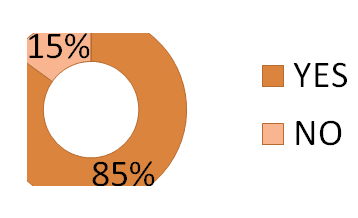
Fig.4.Change According To Situations and Occasions
It was observed that there is a great impact on preferences for legwear as and when the situation changes and occasion demand.
- Impact on personality and body features:
Fig.5. Impact on Personality & Body Features
Majority of women feel that the legwear they choose has a major impact on their personality and affects the look of their body features whereas some women feel the reverse.
- Selection of legwear according to growing fashion:
Fig.6. Legwear According To Growing Fashion
It was seen that majority of women opine that “this is in fashion lets buy” if it’s very trendy , followed by women who donot have their selection matching to growing fashion, and some women agree that sometime their selection depend on fashion knowingly or unknowingly.
- Reason for traditional legwear:
Fig.7. Traditional legwear for the sake of modesty
When respondents were asked whether they prefer their traditional legwear for the sake of modesty, majority of them denied as their prime focus was their comfort level followed by respondents wearing it because of modesty purpose and then by respondents saying who sometimes wore it for reasons of modesty.
- Change in preference for legwear with increasing age:
It was observed that a large number of respondents felt that their preference for leg wear has changed with their increasing age while a good number of the respondents feel that their preference for leg wear changes irrespective of their age.
- Smooth transition observed over the years:
It was tabulated that more than half of the respondents agreed that there is a huge smooth transition taking place in fashion and apparel while some respondents feel that there is no such transitioning happening over the years.
Market study showed that
- Varieties of leg wears have made their appearance in the market.
- The respondents were aware about the smooth transition taking place in the fashion and apparel world and they too had somewhat changed their wardrobe accordingly.Conclusion:
- The latest trend for legwear happening in the market and widely accepted by the Indian women are full Patiala’s and Legging.
- Mostly it was seen that the major influence in legwear was bollywood, the surrounding society and fashion and the apparel industry.
- Designer tags lead to mass acceptance.
- Many factors play a role for selection of legwear in their wardrobe.
- Future trends can be designed by studying changing trends.
Recommendations:
- Changing trends for other apparel wear can also be conducted.
- Changing trends with relation to other aspects like fashion market, recession, psychology of the people, etc. can also be studied.
- Observation method can be used for other groups
References:
- Apparel magazines articles.
- Traditional textiles books.
- Elements of fashion & apparel design: Sumath, G.J., 2002.
- Http://www.Answers.Com/topic/leggings#ixzz23qhu6n5
- Http://www.Answers.Com/topic/leggings#ixzz23qhta6dd
- Http://www.Answers.Com/topic/jeans#ixzz23qjwhohm
- Http://www.Lifescript.Com/life/style/your-look/the_brief_history_of_fashion_trends.Aspx
Http://www.Utepprospector.Com/fashion-trends-of-today-s-society-1.1575464#.Uli7bgcsivo

